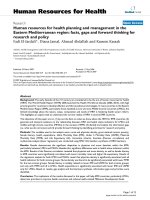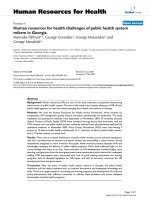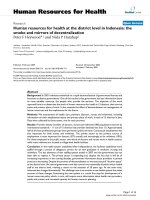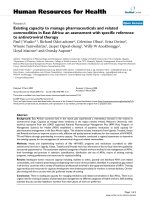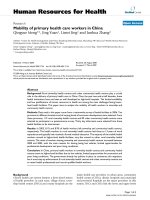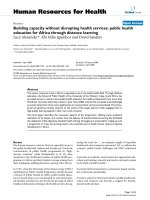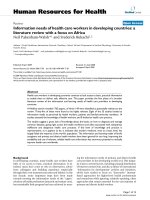báo cáo sinh học:" Developing capacity in health informatics in a resource poor setting: lessons from Peru" pptx
Bạn đang xem bản rút gọn của tài liệu. Xem và tải ngay bản đầy đủ của tài liệu tại đây (219.72 KB, 5 trang )
BioMed Central
Page 1 of 5
(page number not for citation purposes)
Human Resources for Health
Open Access
Commentary
Developing capacity in health informatics in a resource poor
setting: lessons from Peru
Ann Marie Kimball
1
, Walter H Curioso
1,2
, Yuzo Arima*
1
, Sherrilynne Fuller
1
,
Patricia J Garcia
2
, Jose Segovia-Juarez
2
, Jesus M Castagnetto
2
, Fabiola Leon-
Velarde
2
and King K Holmes
1
Address:
1
University of Washington, Seattle, Washington, 98195, USA and
2
Universidad Peruana Cayetano Heredia, Av Honorio Delgado 430
Urbanizacion Ingenieria-San Martin de Porres, Lima 31, Peru
Email: Ann Marie Kimball - ; Walter H Curioso - ;
Yuzo Arima* - ; Sherrilynne Fuller - ; Patricia J Garcia - ;
Jose Segovia-Juarez - ; Jesus M Castagnetto - ; Fabiola Leon-Velarde - ;
King K Holmes -
* Corresponding author
Abstract
The public sectors of developing countries require strengthened capacity in health informatics. In
Peru, where formal university graduate degrees in biomedical and health informatics were lacking
until recently, the AMAUTA Global Informatics Research and Training Program has provided
research and training for health professionals in the region since 1999. The Fogarty International
Center supports the program as a collaborative partnership between Universidad Peruana
Cayetano Heredia in Peru and the University of Washington in the United States of America. The
program aims to train core professionals in health informatics and to strengthen the health
information resource capabilities and accessibility in Peru. The program has achieved considerable
success in the development and institutionalization of informatics research and training programs
in Peru. Projects supported by this program are leading to the development of sustainable training
opportunities for informatics and eight of ten Peruvian fellows trained at the University of
Washington are now developing informatics programs and an information infrastructure in Peru.
In 2007, Universidad Peruana Cayetano Heredia started offering the first graduate diploma
program in biomedical informatics in Peru.
Introduction
Technology serves public health, and an important mis-
sion for public health schools today is to advance knowl-
edge and provide training in 'appropriate technologies'
for the control of diseases of poverty in developing coun-
tries [1]. Appropriate technologies must be developed,
produced, delivered, and monitored within a comprehen-
sive framework that takes into account the systems, the
individuals, and the community [1].
In developed countries, biomedical and public health
informatics have been taught over the last 20-25 years,
with well documented successes and setbacks, providing
good models for future course development and training
Published: 27 October 2009
Human Resources for Health 2009, 7:80 doi:10.1186/1478-4491-7-80
Received: 30 January 2008
Accepted: 27 October 2009
This article is available from: />© 2009 Kimball et al; licensee BioMed Central Ltd.
This is an Open Access article distributed under the terms of the Creative Commons Attribution License ( />),
which permits unrestricted use, distribution, and reproduction in any medium, provided the original work is properly cited.
Human Resources for Health 2009, 7:80 />Page 2 of 5
(page number not for citation purposes)
[2]. Public health informatics can be defined as the sys-
tematic application of information and computer science
and technology to public health practice, research, and
learning [3].
In resource poor settings, informatics represents an
important and emerging focus in healthcare settings,
applicable, for example, to functional genomics, pro-
teomics, clinical care, prevention, disease surveillance,
and disease burden assessment, which are among the
appropriate technological 'core competencies' for medical
and public health research [1]. However, in developing
countries, the need for training and retention of health
professionals in informatics remains one of the greatest
public health challenges. For instance, although a large
proportion of genomic studies of microbial pathogens has
involved pathogens of special importance in developing
countries, involvement of researchers from developing
countries in such projects has been quite limited, con-
straining timely development of bioinformatics capacity
in developing countries [4,5]. Education in medical infor-
matics skills in these regions is also inadequate, and levels
of computer competence vary among medical students,
doctors, nurses, and many other health care professionals
[6]. In 2003, Samuel et al. reported that only 52% of med-
ical students in Tanzania felt that they understood the
basic terminology and concepts of computing [7]. In a
2002 study conducted by Horna et al., 40% of a sample of
medical students in Peru reported lack of proficiency in
the use of the internet [8]. With the growing use of the
internet to gain access to vital health information and for
research [9], informatics training and computer compe-
tency are essential for all health professionals.
Latin America, like other areas of the developing world,
suffers from high incidence of HIV/AIDS, tuberculosis,
and malaria, and of other important but neglected infec-
tious diseases [1]. Improving information systems and
overcoming the digital divide (internet connectivity and
computing capacity) will support the effort to reduce the
morbidity and mortality associated with these diseases
[1,10]. For example, informatics systems such as the Peri-
natal Information System (Sistema de Información Peri-
natal [SIP]), developed by the Latin American Center for
Perinatology and Human Development (CLAP-PAHO/
WHO) [11], have shown that such systems are useful for
quality assurance of care and monitoring of health indica-
tors [12]. More recently, training programs have also been
implemented in Latin America; for instance, the American
Medical Informatics Association's (AMIA) 10 × 10 pro-
gram has been translated and adapted into Spanish by
Hospital Italiano at Buenos Aires [13].
In this paper, we present a case study from Peru that uti-
lizes a comprehensive framework and provides training in
appropriate health informatics technologies. The objec-
tive of this paper is to provide a successful and sustainable
model of a health informatics training program based
upon a comprehensive framework and use of technolo-
gies to support medicine and public health in Peru. The
lessons learned are intended to assist other developing
countries, especially those in Latin America, that wish to
enhance their informatics capabilities.
Development of the AMAUTA Global
Informatics Research and Training program in
Peru
Peru is a developing Andean country on the west coast of
Latin America. Its territory embraces a diverse population
of 27 900 000 with annual per capita gross domestic prod-
uct (GDP) of US$ 8400 [14]. Only 4.3% of the GDP is
devoted to Peru's health care sector [15]. While consid-
ered a middle-income country, Peru remains excluded by
the 'digital divide', with only 9.7% of its citizens owning
private telephones, and only 5.1% having a computer
with internet connection [16]. However, the proliferation
of public 'cabinas' (internet cafés) has provided some
alternative internet access, and has become a research
topic of its own for public health informatics [17]. In
addition, the revolution of cell phones has also come to
facilitate data collection and evaluation in public health
[18].
The AMAUTA Global Training in Health Informatics pro-
gram (AMAUTA is a Quechua word meaning a person of
great wisdom, one who knows and who teaches) was
developed in 1999 to train Peruvian health care profes-
sionals and students in the use, development and applica-
tion of informatics. This collaborative program is an
institutional partnership that has involved Universidad
Peruana Cayetano Heredia (UPCH) and University of San
Marcos of Peru and the University of Washington (UW),
Seattle, Washington USA, with the support of the Fogarty
International Center (FIC), U.S. National Institutes of
Health (NIH). University of San Marcos was partner in the
first five years of the Research and Training program and
remains a collaborator rather than a partner since 2005.
UPCH is recognized as the Peruvian university with the
highest levels in research and training in medicine and
public health. UPCH has been building capacity in
research, training, infrastructure and human resources
while developing key partnerships, with a long history of
funding support from the FIC and other NIH-funded
projects, as well as the Wellcome Trust, the World Health
Organization (WHO), the European Community, and
other regional and national funds (e.g. the Peruvian Sci-
ence and Technology Program). In recent years, UPCH
has been making efforts to develop a structure for online
education, targeting students and professionals with diffi-
Human Resources for Health 2009, 7:80 />Page 3 of 5
(page number not for citation purposes)
culties in accessing the classic educational system. Thus,
the current goals of the AMAUTA program include train-
ing of core professionals in public health/medical infor-
matics and strengthening the library and health
information resource capabilities and accessibility at
UPCH. The program aims to comprehensively strengthen
the informatics training and capacity framework of indi-
viduals, systems, and the community.
The ongoing AMAUTA Program collaboration has been
'rolled out' in a step wise fashion, from individuals to
institutions including: 1) short course offerings in Peru to
identify needs and collaborators and potential trainees; 2)
longer term graduate level training in informatics for core
UPCH faculty; 3) digitization of the UPCH library; and 4)
targeted short term training at the UW for critical need
areas such as library science (in partnership with the UW
Health Sciences Libraries) and laboratory informatics. The
collaborative program has made available a range of
informatics applications (i.e. public health, medical, and
bio-informatics) and offers training opportunities in elec-
tronic data collection methods; resource access at UPCH;
library and information science and appropriate resource
development; open-source learning management systems
(e.g. Moodle); geographic information systems for moni-
toring disease incidence and outbreaks; and bioinformat-
ics training related to the genomics of infectious diseases
(e.g. HIV, syphilis, tuberculosis, and malaria).
AMAUTA has from the start focused on long term capacity
building, training individuals to strengthen the informat-
ics workforce and building capacity at the institutional
system level. Individual training has included both short
and long term training. Short term courses offered in Peru
involve: 1) intensive two week introductory courses on
public health informatics and medical informatics and; 2)
training of trainers, i.e. training of UPCH faculty members
to teach an introductory informatics course to their own
students. Long term training is offered at the UW, where
key UPCH faculty members are trained as researchers and
instructors of informatics through certificate, masters,
post-masters, doctoral, and post-doctoral training pro-
grams, to enhance the core informatics capacity at UPCH
and Peru. This flexible range of opportunities allows both
busy professionals and young students to receive infor-
matics training that suits their needs and schedules. The
training of competent native scientists is essential,
because it allows research communities to grow and con-
duct research that contributes to local improvements in
public health and medicine [9].
So far, four short courses have been organized in Lima in
2000, 2001, 2005, and 2008, offering training in infor-
matics to more than 200 graduate level students. The first
two courses covered topics in medical informatics and
public health informatics through 60 in-class hours of lec-
ture, group exercises, and field/laboratory training [19].
The last two courses covered the same content over 48
hours of coursework each [5]. Participants performed con-
siderably better on the informatics knowledge test after
the course, and overall acceptance of the course was
ranked as very good to excellent, while the usefulness of
the course was rated as very good [5]. Follow-up evalua-
tion six months after the course indicated no decline in
evaluation scores [5]; additional evidence of the AMAUTA
training program's positive outcomes has been described
elsewhere [19]. Furthermore, there are prospects for con-
tinuing growth; for example, UPCH offered the first Grad-
uate Diploma Program in Biomedical Informatics in Peru
in 2007, led by former AMAUTA trainees [20].
At an institutional systems level, the AMAUTA program
has been designed to be sustainable and to encourage the
retention of native scientists in Peru. Visiting scholars
engaged in long term training at the UW are required to
return to Peru, as explained by the training program's offer
letter; in addition, both the trainees' visa and financial
support at UW expire at the time of training completion.
The program generally guarantees a position at UPCH or
another Peruvian institution upon completion, and this
career advancement opportunity has helped prevent the
migration of the skilled workforce from Peru (i.e. 'brain
drain'). Indeed, eight of ten long-term trainees have
returned to Peru and many continue to be engaged in the
public sector. Institutionalization of capacity is also a key
component of sustainable capacity building. Because
individuals with informatics skills are highly prized by
industry and by non-governmental organizations (NGOs)
in Peru, negotiating realistic salaries and careers in univer-
sity settings proved to be a pivotal area of endeavor for the
AMAUTA program.
Since 2000, the program has been successful in identify-
ing internal and external resources and identifying ongo-
ing funding from complementary sources (e.g., Asia
Pacific Economic Cooperation [APEC]) for scholar sup-
port; UPCH was also the only successful foreign submis-
sion for a Fogarty 'Framework Programs for Global
Health' research and training grant in 2005 [21]; and a
returning scholar recently successfully competed for an
R01 Global Research Initiative Program (GRIP) grant
[18].
At UPCH, AMAUTA has forged ongoing and novel part-
nerships between trainees and librarians to develop sus-
tainable databases and interfaces for Peruvian
institutions. For instance, library/resource enrichment
(e.g. state-of-the-art computers with wireless internet con-
nectivity) has recently been completed at UPCH with sup-
port from former trainees. In addition, AMAUTA has
Human Resources for Health 2009, 7:80 />Page 4 of 5
(page number not for citation purposes)
taken innovative advantage of inexpensive and abundant
'cabinas' and cellular telephones throughout much of
Peru. Real-world use of these existing technologies allows
for practical training appropriate for community-level
public health [17]. Reflecting the institutional partner-
ship, instructors and trainees at UW and UPCH commu-
nicate via teleconference and videoconference on a regular
basis for updates on the progress of trainees and sharing
of future plans.
Lastly, the institutionalization of informatics capacity at
UPCH has enhanced the biomedical research capacity at
UPCH through improved information access and infra-
structure. AMAUTA encourages interdisciplinary collabo-
rations between computer scientists and biomedical
scientists, allowing integration of informatics training
with ongoing public health and biomedical research pro-
grams. Continuation of the program has been possible
through shared program management and well-function-
ing technical oversight and coordination. The close pro-
fessional relationships of Peruvian faculty, librarians and
students with their UW counterparts has enriched the pro-
gram and resulted in new research and teaching collabo-
rations at both institutions in ways not envisioned at the
beginning of the program.
Discussion
This brief overview of the AMAUTA Global Informatics
Research and Training Program presents an example of a
successful health informatics training program in a devel-
oping country. AMAUTA has retained a high proportion
of Peruvian scientists in the discipline of informatics in
Peru. Our experience agrees with recent findings that
capacity building is an important strategy in improving
health systems in developing countries [1,11]. In addi-
tion, we have learned that a combination of short and
long term strategies directed at both individual and insti-
tutional capacity have helped to develop the local health
research enterprise [9]. AMAUTA's flexibility and ability to
understand the local context have been major strengths of
the program.
In our experience, a stable funding base over a long period
of time (optimally at least for ten years) has been critical
for the development, nurturing and maintenance of this
collaborative program. The fact that former AMAUTA
trainees continue to compete successfully as principal
investigators for independent funding from several
sources of funding, both nationally and internationally
(e.g. from the UW and the U.S. NIH), provides evidence
of the sustainability and rigor of the training program,
and of the building of local capacity. And, once a stable
funding base and infrastructure have been established, it
is important to pass on the leadership; UPCH, and not the
USA-based UW, has now taken the lead to direct the
project.
Growing interest in global health should increase the
opportunity for such collaborative partnerships aimed at
improving medicine and public health. Public health
schools elsewhere could jump-start their efforts to con-
duct informatics and other appropriate technology train-
ing for developing countries by partnering with other
foundations and institutions [1]. While AMAUTA has
been supported through FIC, another possible source of
support could include the Pan American Health Organiza-
tion (PAHO; />), one of the most effec-
tive public health agencies in the world, which could
assess, enable, and evaluate application of appropriate
informatics technologies in Latin America. In addition, in
the past few years, the private sector and other non-public
entities have made unprecedented commitments to solv-
ing neglected public health problems, and can foster
development of informatics training. The Bill & Melinda
Gates Foundation /> and
Rockefeller Foundation /> are
just a few notable examples. The former has funded AMIA
to develop a global biomedical and health informatics fel-
lowship program />Gates_GlobalFellowshipProgramPR.pdf while the latter
has focused on informatics training through disease sur-
veillance networks />initiatives_dev/pandemics.shtml.
Continuous support from the university authorities has
been essential for the success of the AMAUTA program.
While attracting qualified native professionals trained
abroad is a continuous challenge, the program's ability to
retain 80% of its trainees in informatics in Peru has been
associated with careful selection of candidates, maintain-
ing the connection and collaboration between partner
institutions, and fostering an enabling environment [22].
The program's strength was enhanced by the decision of
the FIC to permit in-country research support for each
returning scholar, and the collaboration with UW
enhanced the ability of UPCH to strengthen its own port-
folio of research projects leading to additional support for
institutionalization.
Conclusion
Collaborative partnerships between countries can opti-
mize training opportunities and human and technologi-
cal resources; such partnerships will undoubtedly become
more important as globalization continues. In this con-
text, we now require a more integrated, practical approach
that includes acquisition of 'real-world' skills in various
technologies [1]; the use of cell phones and 'cabinas' are
just a few examples that we found available and appropri-
ate for Peru [23]. By supporting both short and long term
Publish with Bio Med Central and every
scientist can read your work free of charge
"BioMed Central will be the most significant development for
disseminating the results of biomedical research in our lifetime."
Sir Paul Nurse, Cancer Research UK
Your research papers will be:
available free of charge to the entire biomedical community
peer reviewed and published immediately upon acceptance
cited in PubMed and archived on PubMed Central
yours — you keep the copyright
Submit your manuscript here:
/>BioMedcentral
Human Resources for Health 2009, 7:80 />Page 5 of 5
(page number not for citation purposes)
training programs focused on capacity building of indi-
viduals and institutions, sustainable training programs for
informatics and other appropriate technologies can be
formed in developing countries.
Competing interests
The authors declare that they have no competing interests.
Authors' contributions
AMK conceived of the AMAUTA Program, the scope and
substance of the article and revised and edited the manu-
script and coordinated finalization among authors. WHC
participated in the design and coordination of the pro-
gram, helped draft the manuscript, and revised it critically
for important intellectual content. YA drafted and edited
the manuscript and revised it critically for important intel-
lectual content. SF helped to design and coordinate the
AMAUTA Program and reviewed the manuscript critically.
PJG, JSJ, JMC and FLV helped draft the manuscript and
revised it critically for important intellectual content. KKH
helped to design and coordinate the development of the
AMAUTA Program, and reviewed and edited the manu-
script. All authors read and approved the final manu-
script.
Acknowledgements
We would like to thank Alicia Silva-Santisteban for outstanding program
coordination and to thank all faculty, librarians, students and scholars who
made this program succeed. This work was supported by the University of
Washington AMAUTA Global Informatics Research and Training Program,
a Fogarty International Center (FIC)/U.S. National Institutes of Health
(NIH) funded grant (5D43TW007551), and in part, by a grant from the FIC/
U.S. NIH (1R01TW007896).
References
1. Hotez P, Gupta R, Mahoney R, Poste G: Incorporating appropri-
ate technology into North American schools of public
health. Rev Panam Salud Publica 2006, 19:118-123.
2. Shortliffe EH, Cimino JJ, Eds: Biomedical Informatics: Computer
Applications in Health Care and Biomedicine. 3rd edition.
New York: Springer; 2006.
3. O'Carroll P, Yasnoff W, Ward E, Ripp L, Martin E: Public Health Infor-
matics and Information Systems New York: Springer-Verlag New York,
Inc; 2002.
4. Davila AM, Steindel M, Grisard EC: Tropical diseases, pathogens,
and vectors biodiversity in developing countries: need for
development of genomics and bioinformatics approaches.
Ann N Y Acad Sci 2004, 1026:41-46.
5. Curioso W, Hansen J, Centurion A, Garcia P, Wolf F, Fuller S, Holmes
K, Kimball A: Evaluation of a Joint Bioinformatics and Medical
Informatics International Course in Peru. BMC Medical Educa-
tion 2008, 8:1.
6. Curioso W, Segovia-Juarez J, Rubio C: Situación de la Informática
Biomédica en Perú [Current Situation of Biomedical Infor-
matics in Peru]. Informática y Salud 2007, 64:22-28.
7. Samuel M, Coombes JC, Miranda JJ, Melvin R, Young EJ, Azarmina P:
Assessing computer skills in Tanzanian medical students: an
elective experience. BMC Public Health 2004, 4:37.
8. Horna P, Curioso W, Guillen C, Torres C, Kawano J: Knowledge,
abilities and characteristics of the Internet access in medical
students of a Peruvian university. Anales de la Facultad de Medic-
ina 2002, 63:32-39 [ />].
(In Spanish) Accessed: February 23, 2005
9. Lansang MA, Dennis R: Building capacity in health research in
the developing world. Bull World Health Organ 2004, 82:764-770.
10. Chetley A, Davies J, Trude B, McConnell H, Ramirez R: Improving
health, connecting people: the role of ICTs in the health sec-
tor of developing countries. Washington, D.C.: World Bank,
Information for Development Program [infoDev]; 2006.
11. Simini F: Perinatal information system (SIP): a clinical data-
base in Latin America and the Caribbean. Lancet 1999, 354:75.
12. Simini F, Fernandez A, Sosa C, Diaz Rossello JL: [Perinatal Infor-
mation System. Incorporation latency and impact on perina-
tal clinical registry]. Ginecol Obstet Mex 2001, 69:386-389.
13. Otero P, Hersh W, Luna D, Osornio AL, Quirós FGBd: Translation,
implementation and evaluation of a medical informatics dis-
tance learning course for Latin America. In MEDINFO 2007
Proceedings of the Twelfth World Congress on Health (Medical) Informat-
ics; Brisbane, Australia IOS Press; 2007. CD-ROM P421
14. Population Reference Bureau [ />peru.aspx]
15. Core Health Indicators: Peru [ />base/core/core_select_process.cfm?country=per&indicators=nha]
16. Proenza F, Bastidas-Buch R, Montero G: Telecenters for socioeco-
nomic and rural development in Latin America and the Car-
ibbean. Inter-American Development Bank; 2000.
17. Curioso WH, Blas MM, Nodell B, Alva IE, Kurth AE: Opportunities
for providing web-based interventions to prevent sexually
transmitted infections in Peru. PLoS Med 2007, 4:e11.
18. Evaluation of a Computer-Based System using Cell Phones
for HIV people in Peru. Grant Number:1R01TW007896
[ />doc?textkey=7291149&p_grant_num=1R01TW007896-
01&p_query=&ticket
=45262725&p_audit_session_id=263128313&p_keywords=]
19. Karras BT, Kimball AM, Gonzales V, Pautler NA, Alarcon J, Garcia PJ,
Fuller S: Informatics for Peru in the new millennium. Medinfo
2001, 10:1033-1037.
20. Curioso WH, Kimball A, Garcia PJ, Segovia-Juarez J, Castagnetto JM,
Fuller S: Training Biomedical and Health Informatics Profes-
sionals in Peru: Towards the Development of the First Grad-
uate Diploma Program in the Country. AMIA Annu Symp Proc
2007:1018.
21. Fogarty International Center [ />training_grants/framework/awards.htm]
22. Garcia PJ, Curioso WH: Strategies for aspiring biomedical
researchers in resource-limited environments. PLoS Negl Trop
Dis 2008, 2:e274.
23. Curioso WH: New Technologies and Public Health in Devel-
oping Countries: The Cell PREVEN Project. In The Internet and
Health Care: Theory, Research and Practice Edited by: Murero M, Rice
RE. Mahwah, NJ: Lawrence Erlbaum Associates; 2006:375-393.
